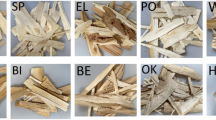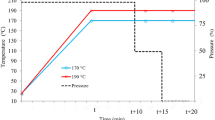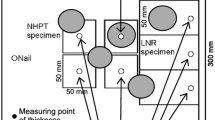Abstract
Randomly oriented strand boards with both uniform and conventional vertical density profiles (VDP) were manufactured, and their properties were evaluated and compared. The bending modulus of elasticity (MOE) of conventional strand boards was predicted using the laminated beam theory and the MOE-density regression equation from the uniform strand boards. The results showed that the predicted MOE of conventional strand boards was close to the measured MOE with a difference of less than 10%. The internal bond strength values of uniform strand boards were found to be higher than conventional strand boards while no significant difference was found in water-related properties. Compared with uniform strand boards, MOE values of conventional strand boards were improved only at higher density level. About 10% of improvement in MOE can be obtained for the strand boards investigated by manipulating the VDP. Steeper VDPs were predicted to be required for thinner boards than for thick boards in order to achieve the same improvement in MOE.










Similar content being viewed by others
References
ASTM D 1037-99 (2004) Standard test methods for evaluating properties of wood-base fiber and particle panel materials. ASTM International, West Conshohocken
Barnes D (2000) An integrated model for the effect of processing parameters on the strength properties of oriented strand wood products. For Prod J 50(11/12):33–42
Bodig J, Jayne BA (1993) Mechanics of wood and wood composites. Krieger Publishing, Malabar, Florida
Carll CG, Link CL (1988) Tensile and compressive MOE of flakeboards. For Prod J 38(1):8–14
CSA O437.1-93 (1993) Test methods for OSB and Waferboard. Canadian Standards Association, Ontario
Dai C, Yu C (2004) Heat and mass transfer in wood composite panels during hot pressing: Part 1. A physical–mathematical model. Wood Fiber Sci 36(34):585–597
Dai C, Yu C, Hubert P (2000) Modeling vertical density profile in wood composite boards. In: Proceedings of the 5th pacific rim bio-based composites symposium. Canberra, Australia. pp 220–226
Dai C, Yu C, Zhou C (2005) Heat and mass transfer in wood composite panels during hot pressing: Part 2. Modeling void formation and mat permeability. Wood Fiber Sci 37(2):242–257
Dai C, Yu C, Zhou C (2007a) Theoretical modeling of bonding characteristics and performance of wood composites. Part I. Inter-element contact. Wood Fiber Sci 39(1):48–55
Dai C, Yu C, Groves K, Lohrasebi H (2007b) Theoretical modeling of bonding characteristics and performance of wood composites. Part II. Resin distribution. Wood Fiber Sci 39(1):56–70
Dai C, Yu C, Jin J (2008) Theoretical modeling of bonding characteristics and performance of wood composites: Part IV. Internal bond strength. Wood Fiber Sci 40(2):146–160
Geimer RL (1979) Data basic to the engineering design of reconstituted flake board. In: Proceedings of 13th International Particleboard/composites materials symposium, Washington State University. pp 105–125
Geimer RL, Montrey HM, Lehmann WF (1975) Effects of layer characteristics on the properties of three-layer particleboard. For Prod J 25(3):19–29
Kelly MW (1977) Critical literature review of relationships between processing parameters and physical properties of particleboard. USDA Forest Service. Forest Product Laboratory, Madison, WI
Lau PWC (1981) Numerical approach to predict the modulus of elasticity of oriented waferboard. Wood Sci 14(2):73–85
Painter G, Budman H, Pritzker M (2006a) Prediction of oriented strand board properties from mat formation and compression operating conditions Part I: Horizontal density distribution and vertical density profile. Wood Sci Technol 40:139–158
Painter G, Budman H, Pritzker M (2006b) Prediction of oriented strand board properties from mat formation and compression operating conditions Part II: MOE prediction and process optimization. Wood Sci Technol 40:291–307
Plath E (1971) A Contribution on particle board mechanics. Holz Roh- Werkst 29(10):377–382
Steidl CM, Wang S, Bennett RM, Winistorfer PM (2003) Tensile and compression properties through the thickness of oriented strand board. For Prod J 53(6):72–80
Suo S, Bowyer J (1994) Simulation modeling of particleboard density profile. Wood Fiber Sci 26(3):397–411
Suo S, Bowyer J (1995) Modeling of strength properties of structural particleboard. Wood Fiber Sci 27(1):84–94
Wang S, Winistorfer P, Moschler W, Helton C (2000) Hot-pressing of oriented strand board by step-closure. For Prod J 50(3):28–34
Wong ED, Zhang M, Wang Q, Kawai S (1999) Formation of the density profile and its effects on the properties of particleboard. Wood Sci Technol 33:327–340
Wong ED, Zhang M, Wang Q, Han G, Kawai S (2000) Formation of the density profile and its effects on the properties of fiberboard. J Wood Sci 46:202–209
Xu W (1999) Influence of vertical density distribution on bending modulus of elasticity of wood composite panels: a theoretical consideration. Wood Fiber Sci 31(3):277–282
Acknowledgments
FPInnovations—Forintek Division would like to thank its industry members, Natural Resources Canada (Canadian Forest Service), and the Provinces of British Columbia, Alberta, Saskatchewan, Manitoba, Ontario, Quebec, Nova Scotia, New Brunswick, as well as Newfoundland and Labrador and the Government of Yukon for their guidance and financial support for this research.
Author information
Authors and Affiliations
Corresponding author
Rights and permissions
About this article
Cite this article
Jin, J., Dai, C., Hsu, W.E. et al. Properties of strand boards with uniform and conventional vertical density profiles. Wood Sci Technol 43, 559–574 (2009). https://doi.org/10.1007/s00226-009-0248-3
Received:
Published:
Issue Date:
DOI: https://doi.org/10.1007/s00226-009-0248-3




